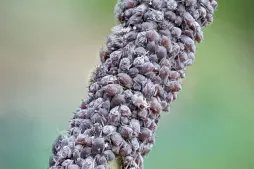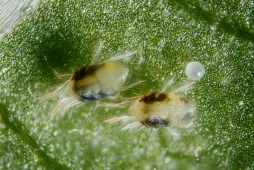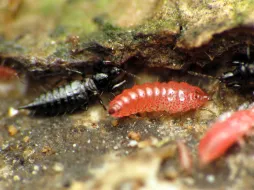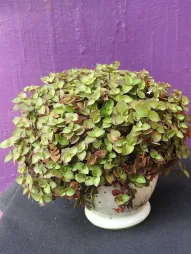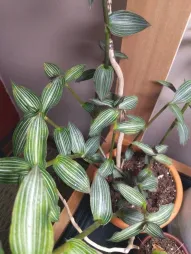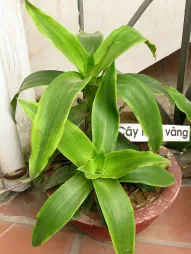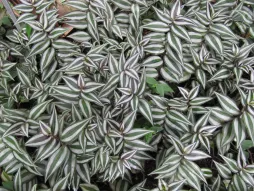Callisia navicularis, a succulent with an air of misery
With its long runners and ephemeral flowers, Callisia navicularis looks like a misery. Both are native to South America and belong to the Commelinaceae family. But Callisia navicularis is a fat plant. It transforms water into juice and stores it in its leaves.
How to recognize Callisia navicularis (Tradescantia navicularis)?
A succulent with a drooping habit, Callisia navicularis is similar in size to callisia repens and Callisia gentlei. It grows to no more than 15 cm in height, and can be up to a metre wide.
Callisia develops two types of stem. The short stems are completely covered by sheathing, alternate leaves. The others are long stolons with bald internodes. They support flowers and a few leaves.
The fleshy leaf blades with hairy margins are green above and purple below. Oval and concave, they resemble miniature boats. This characteristic gave the variety its name. Indeed, in Latin, navicular means boat.
Flowering takes place in summer. The violet or lilac flowers open in the morning and fade before sunset. You then have to wait several days to see a new borage bloom.
Callisia navicularis is not toxic if ingested or touched. You can grow it without fear, and handle it without gloves.
Our maintenance tips
Callisia navicularis are robust and easy to care for. Be careful, however, when handling the plant. The stems are fragile and brittle. If you break one, don't panic. Just take cuttings!
Watering
Callisia navicularis like to keep their feet cool, but can't stand soggy soil. Water when the substrate is dry on the surface, for about three centimetres.
To provide your plant with the nutrients it needs, give preference to rainwater. Avoid tap water, which is often too hard. Finally, to avoid damaging the roots, use water at room temperature.
If you use a saucer or planter, remove any stagnant water. It could rot the root system.
Spray
Brumisez le feuillage avec une eau non calcaire améliore l'hygrométrie et lutte contre les attaques de nuisibles.
Repotting
Every spring, repot your Callisia navicularis to give it more space.
Callisia navicularis need good drainage. Re-pot when its shoots completely occupy the pot, when the substrate no longer absorbs water or when the roots escape from the pot.
Choose a pierced terracotta pot. This material allows the potting compost to dry out evenly, even at depth.
Remove any dried leaves and remove all the previous potting mix.
At the bottom of the pot, place a drainage layer, such as clay balls, and fill with a special succulent substrate. You can also make a mixture of ordinary potting soil, garden soil and river sand.
Plant in the center without burying the crown.
When the roots are tight and starting to curl, repot the graft at the foot of your mother plant or in a pierced pot with a suitable substrate.
Once the first roots appear, you can transplant your stem with the mother plant, to densify it.
If you wish to create a new plant, prepare a perforated pot lined with a drainage layer (clay balls, gravel, pebbles). Then pour in potting soil for cacti and succulents. Make a pilot hole and plant your cutting. For a fuller specimen, you can place several stems in the pot. Water with non-calcareous water to facilitate rooting.
Fertilization
To promote the growth of your Callisia navicularis, apply fertilizer in spring and summer.
Apply fertilizer for succulents to accelerate growth.
Prune
Cut dead leaves with a sharp, clean tool.
Pinch
Pinch your Callisia navicularis during its growing season.
Pinching improves branching. When new leaves appear, take them between your fingers. Section the leaf with your fingernails.
Cutting
Cutting is carried out during the strong growth phase, generally in spring and early summer.
Using clean, sharp scissors, remove the tip of a branch. Remove a section at least fifteen centimetres long (five or six knots).
Immerse the lower part of your cutting inclear water at room temperature. Make sure the level remains even and the liquid clean.
Protect your cutting from direct sunlight.
Protect your cutting from direct sunlight.
Diseases / Threats
Information
| Family | Commelinaceae - Commelinaceae |
| Type | Callisia - Callisia |
| Species | Callisia navicularis - Callisia navicularis |
| Lifecycle | Perennial |
| Foliage | Evergreen |
| Exposures | |
| Substrats | |
| Planting method |
In pots |
| Categories | |
| Tags |
Beginner Flowery Fritillary Increvable |
| Origins |
Central America South America |
| Hardiness (USDA) | 10a |
| Leaf color |
|
| Flower colors |
|
Discover plants from the same family













